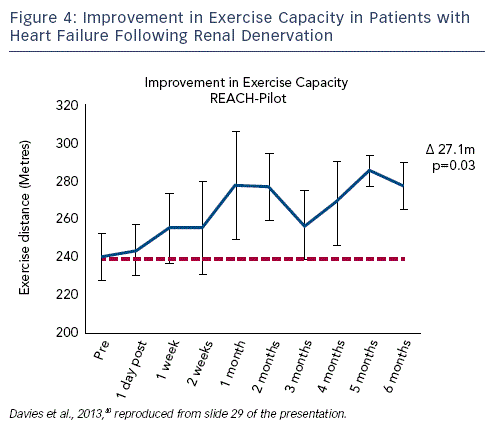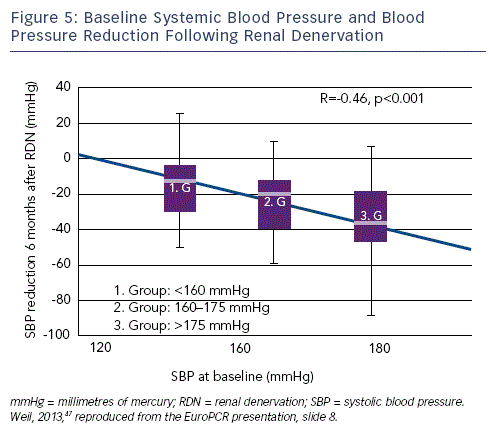 New Therapeutic Indications for Renal Denervation
New Therapeutic Indications for Renal Denervation
Evolving applications for RDN in disease conditions related to sympathetic overactivity may expand its therapeutic indications. The sympathetic nervous system has an impact on a number of cardiovascular and metabolic diseases,31 and possible indications for RDN include the treatment of glycemic control,32 sleep apnoea,32 cardiac systolic and diastolic dysfunction,33,34 LVH,33 polycystic ovary syndrome34 and end-stage renal failure.35
The mechanisms that underlie heart failure may also benet from RDN. In congestive heart failure, sympathetic overactivation that accompanies decreased cardiac output causes renin release, sodium and uid retention, and reduces renal blood ow, leading to arterial constriction and increased heart rate. An increase in plasma levels of angiotensin II, partly mediated by renal sympathetic activation, acts on the central nervous system to further increase global sympathetic tone.36 Renal sympathetic activity causes norepinephrine activation; levels of plasma norepinephrine correlate with mortality in patients with congestive heart failure.37 Two mechanisms are thought to be responsible for uid retention - a slow renal mechanism and a faster pathway whereby the splanchnic venous reservoir becomes activated and blood becomes immobilised.38
Another clinical feature of heart failure is overactivation of central chemoreceptors, modulated by sympathetic pathways, which causes breathlessness. Chemoreceptor sensitivity increases with worsening heart failure and high chemoreceptor activation is associated with increased mortality.39 Numerous effective drugs are available for the treatment of arterial constriction and diuretics can help in the management of uid retention. However, there are few options for modifying the sensitivity of the chemoreceptors that control breathing. RDN offers the potential to modulate central chemoreceptors, improve uid balance, reduce heart rate and cause a decrease in peripheral vascular resistance.
 A small pilot study (n=7) assessed the safety of RDN in patients with chronic heart failure and on maximal tolerated heart failure therapy.40 Patients were hospitalised for a day before the procedure and up to ve days after, and were closely followed up. No procedural or post-procedural complications were observed during six months of follow-up. Improvements in both symptoms and exercise capacity were reported, and the resulting reduction in BP was negligible and remained stable. The six-minute walk distance was signicantly increased at six months (=27.1 +/- 9.7 m, p=0.03), with each patient experiencing an increase (see Figure 4). The procedure also resulted in dose reduction in some medications, in particular diuretic dosage, which was reduced in four of the seven patients.
A small pilot study (n=7) assessed the safety of RDN in patients with chronic heart failure and on maximal tolerated heart failure therapy.40 Patients were hospitalised for a day before the procedure and up to ve days after, and were closely followed up. No procedural or post-procedural complications were observed during six months of follow-up. Improvements in both symptoms and exercise capacity were reported, and the resulting reduction in BP was negligible and remained stable. The six-minute walk distance was signicantly increased at six months (=27.1 +/- 9.7 m, p=0.03), with each patient experiencing an increase (see Figure 4). The procedure also resulted in dose reduction in some medications, in particular diuretic dosage, which was reduced in four of the seven patients.
In a larger study of patients with advanced heart failure (n=51, 12 months), 26 patients were treated with RDN and standard pharmacotherapy and 25 patients received standard drug treatment with beta-blockers, angiotensin-converting enzyme (ACE) inhibitors or angiotensin receptor blockers (ARBs) and diuretics. No acute or medium term complications were observed in the RDN group. The RDN group reported an increase in ejection fraction, a lower cumulative frequency of hospitalisations for heart failure, and also showed other interesting trends, such as a reduction in the N-terminal pro-hormone of brain natriuretic peptide (NT proBNP), a reliable indicator of the severity of heart failure.41
Several ongoing studies aim to assess the safety and efcacy of RDN in heart failure. These include the SYMPLICITY-HF trial (n=40), and the Renal Artery Denervation in Chronic Heart Failure (REACH) trial (n=100). In summary, RDN may offer the potential to expand its indications beyond resistant hypertension.
Following current consensus papers, around 10-15 % of current patients are suitable for RDN, and proper evaluation is important. Firstly, it is necessary to identify patients who have truly resistant hypertension, taking into account compliance issues. In patients with resistant hypertension, secondary causes of hypertension are common.42 Therefore a detailed screening process is required to identify patients with potentially curable forms of hypertension, since RDN has not been evaluated for efcacy in these patients.27
Ultimately, the success of RDN rests on building a referral network. Evaluation of patients for secondary hypertension and end-organ damage often requires different specialists. A multidisciplinary team is therefore recommended, including hypertension experts, radiologists, nephrologists, endocrinologists and both interventional and noninvasive cardiologists to exclude secondary causes of hypertension and make the right decision for each individual patient.43 The importance of the multidisciplinary approach has been stressed by hypertension experts and has proven successful in daily practice.27,44 It is important to identify the referring physicians, which may be a family practitioner rather than a specialist. Involvement of local physicians can help to spread awareness and knowledge about the procedure.
In targeting appropriate patients for RDN, the new European Society of Hypertension (ESH) guidelines45 are useful - ofce BP 160 mmHg systolic (diabetics 150 mmHg); a stable drug regimen including a diuretic and three different antihypertensive drugs and age over 18 years. Currently, the only parameter identied that predicts response to RDN is baseline SBP - a correlation has been demonstrated between BP reduction after RDN at six months follow-up and SBP baseline values (see Figure 5).46
The establishment of an RDN referral network maintains a streamlined patient evaluation. In a referral network established in Lubeck, Germany, 41 % of patients were excluded because they were taking less than three medications and 26 % were excluded because they had a SBP <160 mgHg. Twenty-six percent of all the patients seen were treated with RDN. The SBP at baseline was around 180 mmHg, he reduction in BP observed was about 26 mmHg. These real-world data are similar to those observed in clinical trials.47
In summary, patient selection is crucial to the success of a RDN programme. In order to optimise patient selection, it is important to build a multidisciplinary referral network by personal communication and quality of medical treatment.